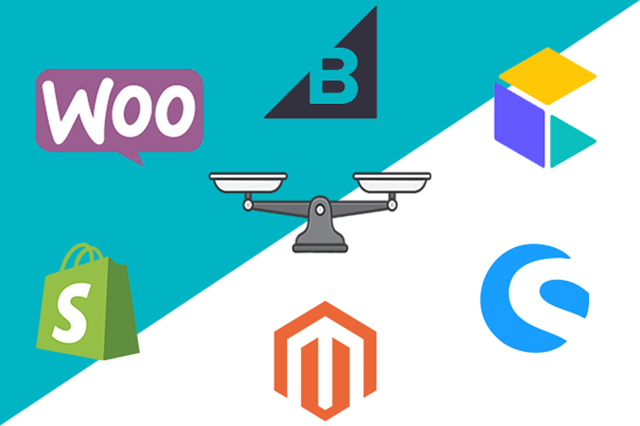Are you planning to build or relaunch your online shop and wondering: Which e-commerce infrastructure is right for you? This decision affects far more than just technology. It impacts your growth, your processes, and your e-commerce success.
Whether in Germany, Switzerland, or international markets, the choice of powerful e-commerce platforms is vast. This is precisely what makes the decision so challenging.
Not every backend is suitable for every business model. Many solutions, in addition to their advantages, also have dependencies, ongoing costs, and technical limitations that you should be aware of.
In this article, you'll get a comprehensive overview of the current state of e-commerce platforms. You'll learn the differences between SaaS, open source, and headless. You'll gain clear criteria for finding the right solution.
Our shop system comparison shows you which platform suits your business model.
Shop systems comparison: How modern e-commerce platforms work
E-commerce software is the technical basis of your online business. It enables you to
- Selling products online
- including product management
- Order processing
- Payment integration
- Shipping control
- Customer management
But a modern backend can now do much more than just map transactions.
Three basic types dominate the market:
SaaS (Software as a Service)
- Fully hosted in the cloud
- Quick setup, low technical effort
- Ideal for scaling brands without their own developers
- Examples: Shopify Plus , BigCommerce
Open Source Shops
- Freely available, but with own hosting and platform maintenance
- High flexibility, full control
- For companies with IT expertise or agency partners
- Examples: Magento , Shopware 6 (Community Edition), WooCommerce
Headless & API-first systems (Composable Commerce)
- Frontend and backend are decoupled
- Maximum customization, often for enterprise architectures
- Need for developers, DevOps and stable architecture
- Examples: Commercetools , Vue Storefront with Shopify
SaaS solutions or content-driven setups are particularly popular for beginners. Those who have to choose between the two will find valuable guidance in our direct comparison of WooCommerce vs. Shopify .
The choice is therefore not just a question of the interface, but a fundamental architectural decision. Depending on the type, setup times, development costs, technical operating effort, and scalability vary considerably.

How to find the right online shop platform: The 9 most important criteria at a glance
Choosing a specific platform is a strategic decision, as it must be sustainable in the long term. Here are the nine most important criteria you should consider.
When comparing different trading platforms, you shouldn't just consider features. Long-term scalability, ongoing costs, and how well the platform fits your team are also crucial.
These criteria help you to realistically evaluate platforms and sensibly align technology, business model, and growth.
1. Time-to-market & flexibility
In e-commerce, weeks, sometimes days, often determine the success of a campaign, a new product, or an expansion. A late launch costs visibility, conversions, and revenue – especially in a market characterized by speed.
That's why time to market is one of the most powerful levers for growth. A powerful sales solution gives you the freedom to launch new products quickly.
Your team can maintain content independently, without developers or lengthy approvals.
Landing pages, campaigns, or tests can be implemented flexibly and quickly, even without compromising on quality, security, or performance. This isn't about bypassing developers; quite the opposite. It's about using them where they create the greatest strategic value.
While marketing and e-commerce operate independently, developers can focus on what enables sustainable growth: custom features, integrations, automation, and technical scaling.
If a relaunch takes several months or every small change ties up technical resources, a structural growth problem arises. This quickly becomes a trap, especially for rapidly scaling brands.
In dynamic markets, speed often determines visibility, conversion, and sales. Anything that goes live too late won't be discovered or purchased.
Flexibility doesn't just mean speed, but also true freedom of action. Your software should allow you to react to market changes at short notice. Whether it's new sales channels, seasonal peaks, or spontaneous product drops, you should be able to implement quickly, without system disruptions, manual detours, or unnecessary complexity.
Whether A/B testing a pricing strategy, launching a new product range, or expanding into a new market, your backend needs to keep pace with your pace and strategic development, or even be ahead of it.

2. Scalability
Whether you process 100 or 100,000 orders per month, your backend must function reliably. Scalability means much more than just technical stability with increasing traffic. It's about the ability to grow with your business model, in terms of function, structure, and market complexity .
A scalable backend forms the basis for sustainable growth. You can integrate new markets, products, or channels without constantly rebuilding your technical foundation.
Specifically, this means:
- How easy is it to connect a new warehouse or fulfillment partner, locally or internationally?
- How many countries, domains, or storefronts can you run in parallel without losing track?
- How automated are your processes or do you still need manual interim solutions for each new process?
Scaling affects not only your IT, but your entire business model. When every expansion requires specialized technical solutions, things quickly become complex. If your backend becomes unstable under heavy load, it slows your growth at precisely the crucial moment.
The scalability of an e-commerce platform is particularly evident during predictable peaks. These include Black Friday, seasonal drops, TV broadcasts, or viral influencer campaigns.
Many platforms crash at critical moments. Systems like Shopify Plus or BigCommerce distribute load automatically and reliably. CDN-based load optimization and a stable infrastructure ensure reliable performance even under high traffic.
Growth doesn't require a new tool. It requires a solution that grows with you.
Scalability isn't just a technical capability. It's a strategic requirement for brands that want to grow and aren't content with standing still.
3. Extensibility & Ecosystem
No e-commerce platform, no matter how modern, can meet all requirements out of the box. That's why a strong, extensible ecosystem is one of the most important success factors in e-commerce. The question isn't whether you need additional features, but how easily, securely, and low-maintenance you can integrate them.
Especially for fast-growing brands, requirements often change faster than they can be technically developed. Do you want to launch a loyalty program, integrate a subscription model, sell internationally in a tax-compliant manner, or seamlessly integrate your CRM?
Then you need software that doesn't make you build these functions, but provides them immediately.
Instead of having to develop each extension individually, you should have access to tested, documented, and maintained apps and modules . Ideally, they should be integrated in such a way that they don't destabilize your existing setup.
SaaS platforms such as Shopify Plus or BigCommerce offer a massive advantage here:
- Several thousand certified extensions
- Curated app stores with quality control
- Stable APIs for deep integrations
- Updates and security standards directly from the provider
This not only saves time and development costs, but also reduces the risk of technical debt or system conflicts. New features can be integrated with just a few clicks. No downtime, no lengthy testing, and no risk to ongoing operations.
While open-source systems like Magento or the Shopware alternative offer considerable potential for expansion, many plugins are technically outdated or unstable. This leads to system stability issues, especially in more complex setups, and hampers long-term development.
A high-performance, well-maintained ecosystem is therefore more than an add-on; it's a strategic advantage. It makes you faster and more independent. You can test and expand innovations without having to constantly rebuild your setup.
A good e-commerce platform not only grows with your functionality, it also provides you with the tools to expand further at any time.
4. Globalization
If you want to sell across national borders, a simple translation of your homepage isn't enough. A well-thought-out globalization strategy must go much further and be properly supported both technically and organizationally.
The key requirements include:
- Multilingualism , including SEO-relevant URLs and metadata
- Currency variety , with live exchange rates or fixed prices per market
- Country-specific taxes (e.g. EU, UK, Switzerland) and legal requirements (e.g. withdrawal, data protection)
- Local payment methods such as Klarna, iDeal or Twint
- Regional fulfillment processes , such as shipping from local warehouses or customs clearance
- Different product prices or content depending on the market or customer segment
Many online shop solutions only partially meet these requirements, often only through costly extensions, external tools, or technical workarounds. This is not only inefficient but also carries a high potential for errors and maintenance over the long term.
Modern backends like Shopify Plus or BigCommerce support multiple regions. This includes substores, international domains, and flexible tax logic. Product feeds can also be adapted regionally, including appropriate currencies.
However, it's not just what the backend offers that's crucial, but how efficiently your team can work with it. Because with each new market, operational complexity increases. If content, prices, or shipping options have to be maintained individually for each country, the scalability of your store suffers considerably.
Only with centralized, structured management logic can you efficiently serve dynamic markets without unnecessarily bloating your setup. Globalization isn't a function; it's a discipline. Your platform should be designed precisely for it.

5. B2B capability
Different rules apply in B2B than in B2C. Price lists, ordering processes, customer structures—your store must be able to map all of these natively or extensibly.
A B2B-capable platform ideally offers:
- Customer-specific ranges & prices
- Net prices including correct tax logic
- Login-protected shopping areas with individual product views
- Minimum order quantities, tiered prices, payment terms & approval processes
In addition, there are requirements such as multi-level role models , individual approvals , or automated requests for quotations , especially for key accounts or framework agreements.
Many companies also expect seamless integration with existing systems such as ERP, CRM, or PIM . This often includes automated data exchange via API or EDI.
Platforms like Shopify Plus , BigCommerce , or Shopware already offer native B2B functionality with a high degree of practical relevance. Magento or Commercetools , on the other hand, usually require more in-depth customization, but in return, you get maximum flexibility for complex setups.
It's important to remember that your e-commerce software shouldn't just "kind of do B2B," but rather map scalable, digital sales processes. It must enable you to automate your B2B business long-term. International expansion and data-driven management should also be seamless. This is the only way to transform a store into a true digital sales channel.
6. Omnichannel & Multichannel Sales
Modern shoppers research online, purchase on mobile devices, compare products on marketplaces, and interact via social media. A digital sales platform must reflect this connected purchasing experience, with centralized management and synchronization of all channels:
- Social Commerce (Instagram, TikTok, Pinterest)
- Marketplaces (Amazon, eBay, Zalando)
- POS systems for brick-and-mortar stores and pop-ups
- Mobile apps , web apps or storefronts via API
- Google Shopping & digital campaign channels
The more channels you operate in parallel, the more important real-time synchronization of product data, inventory levels, prices, and promotions becomes. This is the only way to create seamless, consistent shopping experiences across all channels.
Platforms with native multichannel architecture enable you to quickly activate new channels or target them specifically. Data remains consistent, without loss or system disruption. This saves resources, accelerates campaigns, and strengthens your brand presence across all relevant sales channels.
Especially for fast-growing brands, multichannel is not only a revenue lever, but also a valuable competitive differentiator . Those who think cross-channel early on can more effectively address trends and consistently manage the customer journey, from the first interaction to conversion.
7. Security & Compliance
Security isn't an added benefit in e-commerce, but an absolute prerequisite. Especially in markets like Germany and Switzerland, high legal standards apply: GDPR , PCI-DSS , SSL encryption , data deletion obligations , and clearly defined server locations —your shop must actively and reliably comply with all of these.
SaaS platforms such as Shopify or BigCommerce handle central security and compliance issues directly at the system level.
You benefit from:
- regular security patches
- encrypted data processing
- certified server infrastructure
- automatic DDoS protection
- a documented hosting model
With open source systems, security responsibility lies with you or your agency.
This means, among other things:
- Effort for regular security audits
- permanent monitoring
- Management and renewal of SSL certificates
- legal audits on data protection compliance
- manual closing of security gaps
- additional time expenditure as well as higher costs and risks
Stable shop software prevents downtime and reliably protects your customers' data. At the same time, it strengthens trust in your brand, both technically and communicatively. Because compliance isn't a tedious effort, but a real competitive advantage.
A robust security foundation is essential, especially for growing brands with high transaction volumes or an international setup.
8. Cost structure & operating costs
What initially seems inexpensive can become expensive in the long run. Therefore, you should realistically estimate the total cost of ownership (TCO) , especially as your expectations and goals grow.
Not only license costs need to be taken into account, but also:
- Hosting & Infrastructure
- Maintenance and technical support
- Developer costs for new features
- Costs for extensions & integrations
- Agency services or internal IT resources
- Efforts for security, updates, testing and documentation
SaaS platforms like Shopify Plus or BigCommerce typically offer transparent pricing models with fixed monthly rates and included features. This simplifies budget planning and reduces unexpected additional costs.
With open-source and headless solutions, ongoing costs increase rapidly, especially for custom developments, custom logic, or complex architectures with third-party integrations. Even small changes can result in high development costs.
A clear overview of costs helps you invest specifically in growth, user experience, or marketing, rather than in technical maintenance. This is precisely where economic scaling separates from costly complexity.
9. User-friendliness & Autonomy
How efficiently your team works with the shop software determines speed, costs, and campaign capability. Good e-commerce software allows you to independently maintain products, implement promotions, and manage content flexibly.
You don't have to wait for developers or agencies, which saves time and increases your implementation speed.
This not only reduces operational dependencies, but also promotes personal responsibility, efficiency, and speed in marketing and e-commerce.
Autonomy is particularly crucial for fast go-to-market strategies, seasonal campaigns, or data-driven testing, because reaction time is sales time .
Internal teams also benefit: Creative ideas can be implemented more quickly, A/B tests can be carried out independently, and data-based decisions can be visualized directly in the system.
Onboarding processes are shortened and training effort is reduced. Your team works significantly more agilely, especially when interfaces and dashboards are designed intuitively.
Backends like Shopify, BigCommerce, or modern headless interfaces offer excellent user experiences with well-thought-out dashboards and clear role allocation. More complex platforms like Magento or Commercetools can do a lot, but only with the appropriate expertise, technical training, or ongoing external support.

The 6 most important platforms at a glance
|
system |
Strengthen |
challenges |
|
Shopify Plus System type: |
Fast time-to-market, scalability included, intuitive operation, strong app ecosystem |
Checkout customization only in Plus, limited backend freedom |
|
Shopware 6 System type: |
GDPR-ready, headless-ready, customizable |
Higher technical complexity, hosting required |
|
Magento / Adobe Commerce System type: |
Extremely customizable, deep B2B functionality, globally applicable |
Long development cycles, maintenance-intensive |
|
BigCommerce System type: |
API-first, headless possible, no transaction fees |
Little DACH presence, UI less intuitive |
|
WooCommerce System type: |
Low entry costs, good content integration, large community |
Scaling & security weak, hosting dependent |
|
Commerce tools System type: |
Microservices architecture, high scalability, future-proof |
Complex setup, DevOps required |
Shop systems in focus: The 4 key areas for your e-commerce platform
A simple comparison of e-commerce platforms is often not enough if you want to make a sustainable decision for your e-commerce business. Modern platforms differ not only in functionality, but also in architecture, flexibility, ease of use, and cost structure.
In this section, you'll learn how to realistically evaluate e-commerce shop systems . How to optimally combine technology and business model without getting bogged down in complex spreadsheets.
1. Technical basis: stability & extensibility
Technology is the backbone of your store. If it's unstable or difficult to expand, every new process becomes a challenge. Therefore, you should examine how the system performs on a day-to-day basis and what you can expect in terms of scaling and expansion.
Hosting & Infrastructure :
- Does the system use automated cloud hosting that remains stable under high load?
- Or do you need your own hosting setup with maintenance responsibility?
This is where SaaS often diverges from open source.
Safety & Maintenance :
- Who takes care of security updates, SSL certificates , and GDPR compliance? With SaaS, this is part of the system; with open source, it's up to you or your agency.
Extensibility :
- How good is the plugin or app ecosystem?
- Are there approved extensions, or do you have to develop many features yourself (or have them developed)? Growing brands, in particular, need stable, low-maintenance solutions.
Systems like Shopify Plus offer many features built right in, giving you flexibility without the technical baggage.
2. Operation & Usability: How well does the system fit your team?
Technical excellence is useless if your team can't use it. A good system must be fast, intuitive, and self-usable in everyday use. This is especially important for smaller teams without significant development resources.
Time to market :
- How quickly can you bring new products live?
- Can your marketing team get started right away, or does everything have to go through developers first?
Usability in everyday life :
- Can content, actions or pages be maintained independently?
- Is there a clear backend or do you need training?
Autonomy :
- How independent can you be? If you need to customize every button, you lose speed, budget, and flexibility.
In the online shop system comparison, SaaS solutions score particularly well because they offer clearly structured admin areas and intuitive dashboards.
3. Scaling & Sales: Does the system grow with your business?
Your system shouldn't limit you, but rather grow with you in terms of traffic, team size, target markets, and features. If you're ambitious, you need a system that will still keep up in two or five years.
Performance :
- Is the store stable even during traffic peaks? This is especially important during launches, campaigns, or seasonal peaks.
B2B & Multichannel :
- Are there native features for B2B processes, marketplace connections, or point-of-sale systems?
- Or do you have to connect everything individually?
Internationalization :
- Does the system support multilingualism, tax logic, international domains, or regional payment methods?
This shows that systems with modular architecture and global orientation have a clear advantage.
4. Profitability: Keep an eye on costs and conversion
Not only the technology, but also the budget determines success. Many platforms appear inexpensive at first glance, but upon closer inspection, hidden costs lie in hosting, maintenance, or custom development.
Total costs :
- What does the system really cost per year, including hosting, maintenance, support, and future expansion? Not just initially, but in the long run.
Conversion focus :
- How efficient is the checkout process?
- Are there fast loading times, mobile optimization, and trust-building elements?
When evaluating online shop platforms, it becomes clear that a transparent cost structure and a strong checkout process are real competitive advantages and prevent later technical problems.
And what does that mean specifically?
When comparing platforms, don't just focus on features. It's about how the system supports your growth , empowers your team, simplifies your processes, and remains cost-effective in the long term.
The best choice is not based on the number of features, but on asking the right questions for your business model.
Anyone who wants to scale needs more than just solid technology. It requires a system that can grow flexibly, without becoming a major IT project with every new feature or market . This is precisely where the real differences between the platforms become apparent in everyday life.
Some solutions come with core features right out of the box, while others require in-depth customization. It's important that your e-commerce software doesn't become a brake on growth, but rather supports you in achieving new goals faster.
Which platform suits which business model?
|
system |
Suitable for |
|
WooCommerce |
Startups, MVPs , content commerce, WordPress-related projects |
|
Shopify Basic |
Beginners, MVPs |
|
Shopify Plus |
Fast-scaling D2C brands, B2B with moderate complexity |
|
BigCommerce |
Fast-growing brands with an API focus |
|
Shopware 6 |
Medium-sized B2B companies with individual processes |
|
Magento / Adobe Commerce |
Large B2B setups, companies with highly customized requirements |
|
Commerce tools |
Enterprise architectures, modular headless strategies |
Shop systems in Germany & Switzerland
Depending on your target market, the legal, technical, and cultural requirements for your system vary. National characteristics are particularly important in German-speaking countries. A platform that works well internationally is not automatically DACH-ready.
In Germany:
- Shopify, Shopware and WooCommerce are widely used, especially among medium-sized businesses.
- Magento is often used in corporations or IT-intensive B2B structures.
- GDPR , GoBD, legally compliant checkout processes and popular payment methods such as Klarna and PayPal are key requirements.
In Switzerland:
- Shopify is growing rapidly, especially among modern D2C brands.
- Local payment methods (e.g. PostFinance, Twint), multilingualism (DE/FR/IT) and CHF pricing are mandatory.
- Many providers rely on individual integration partners; the market is more technically independent than in Germany.
What does this mean for you?
If you want to scale in the DACH region, your e-commerce platform should support local requirements natively or cover them with tested extensions. Tax logic, language settings, country-specific checkouts, and payment methods in particular shouldn't be an afterthought. They must be part of your setup from the start.
Conclusion: Which system is right for you?
A backend isn't just a technical tool; it's the backbone of your online business. It determines how quickly you go live, how adaptable your setup is, and how productive your team can be. The right decision has a direct impact on revenue, growth, and brand strength .
The comparison of shop systems clearly shows: There isn't one solution for everyone. Rather, it depends on what you're planning and how quickly you want to grow.
- Shopify Plus offers fast implementation, strong scalability, and low maintenance, making it ideal for fast-growing D2C brands.
- Shopware is suitable for B2B-oriented medium-sized companies that want to customize their processes.
- Magento (Adobe Commerce) offers maximum control, but is more suitable for large teams with their own IT.
- BigCommerce is an insider tip for tech-savvy brands with SaaS advantages.
- WooCommerce is particularly suitable for WordPress-related projects with manageable volume.
- Commercetools targets companies with a headless strategy and API focus.
Our advice: Do not choose the “most powerful” backend, but the one that suits your team,
fits your processes and growth strategy. If you need support, we'll help you with experience, technical expertise, and a clear focus on what matters most.
Datora is your specialized Shopify Plus Development Agency .
We develop features that drive your growth. Customized, scalable, and beyond the standards.
Whether it's complex B2B processes, customized product logic , or a scalable architecture for international markets, we get the most out of your solution – technically precise, future-proof, and with a focus on performance.
Interested in more comparisons? Check out these topics:
- Shopify vs Etsy
- Bigcommerce vs Shopify
- Shopify Plus vs Magento
- Scayle vs Shopify Plus







